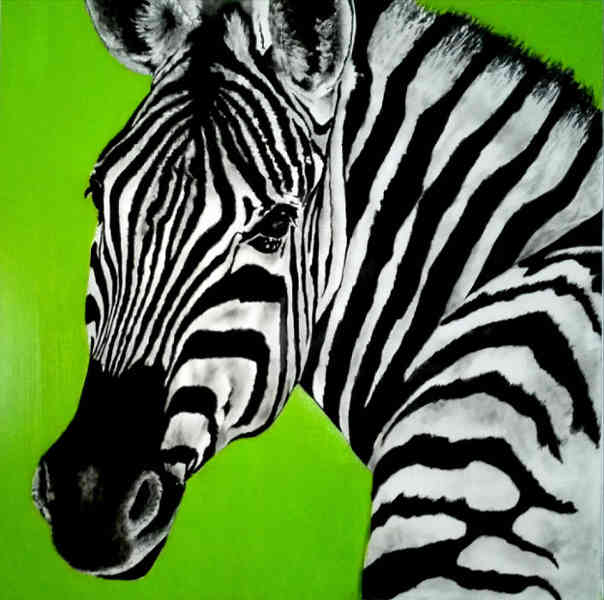
Hi friends, today I want to show you my first zebra: it is painted in oil, on a canvas 100 cm x 100 cm, on a beautiful bright green background.
I chose to paint this animal because I like its sweet muzzle, the wet look, the extraordinary stripes of the coat. I chose the green background because it recalls the colors of the savannah in the rainy season.
This painting was exhibited in 2018 at the Farini Gallery in Bologna and in 2017 at the Ruota della Fortuna Gallery in Cagliari.
Look at the gallery with all my paintings: https://www.tizianasanna.com/en/animals
All my paintings are entirely handpainted and are unique and original pieces with a certificate of authenticity.
I use colors and materials of the best brands, large and high quality canvases mounted on a 4 cm thick frame. The painting continues on all edges and is immediately ready to be exhibited in the environment you prefer.
The result is a very modern work of the highest quality, with attention to every detail.
My artworks, of hyperrealistic and with a photographic style, have got as main subjects animals, mostly exotic ones such as elephants, giraffes or leopards, or typical of the Sardinian territory. I manage to highlight the details, meticulously cared for, and to focus attention on the subject, which is the only character of the work: the background, in fact, is absent, it is mostly monochrome and it emphasizes the focus on the animal, abstracting and extracting it from a real space.
My style is defined as pop - hyperrealism because the subjects are painted following a detailed technique, but their position in an unreal space gives the artworks features that are more typical of pop art, so hyperrealism and a graphic style melt. I use different techniques according to the subject and the effects I want to obtein.
Some information about zebras
Zebras have been reduced in number by hunting and habitat loss. Zebras are herbivorous mammals, belonging, like the horse, to the Equidae family. Distributed in the eastern and southern regions of Africa, zebras are markedly distinguished from other members of the family by the vertical streaks, black or brown-reddish, alternating with light, white or yellowish bands, on the front quarters, which often tend to the horizontal on the hindquarters of the animal.
Zebras were and still are hunted for their skins and flesh. They also compete with forage cattle. The Cape Mountain zebra has been hunted to near extinction, with less than 100 individuals by 1930. Since then, the population has increased to around 700 individuals due to conservation efforts. The subspecies of the mountain zebra is currently protected in national parks, but is still endangered. Grévy's zebra is also in danger. Hunting and competition from livestock have significantly reduced its population.
Due to the small size of the population, environmental hazards such as drought are able to affect the whole species. Flat zebras are much more numerous and have a healthy population. However, they too have been reduced in number by hunting and habitat loss in favor of agriculture. A subspecies, the quagga, is now extinct.
In the photo: pop-hyper-realistic painting of the zebra on a bright green background made on a canvas 100 cm x 100 cm with oil colors by Tisha (Tiziana Sanna)
In the picture: pop-hyperrealistic painting of zebra, realized with oil colors on a canvas 100 cm x 100 cm by Tisha ( Tiziana Sanna )